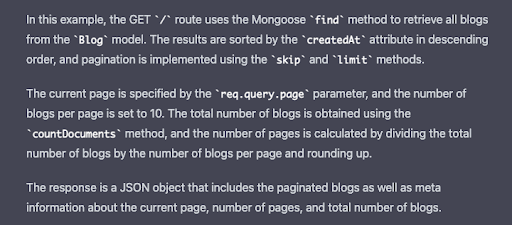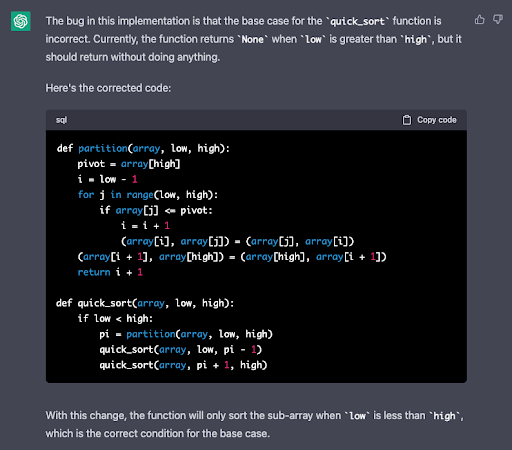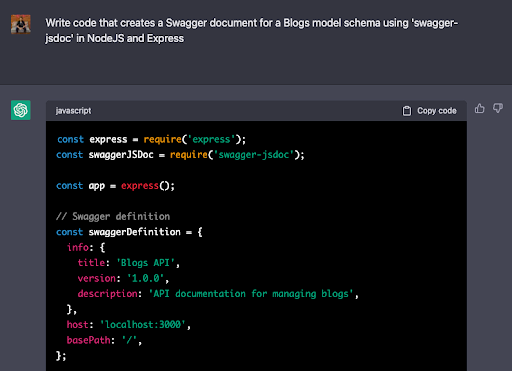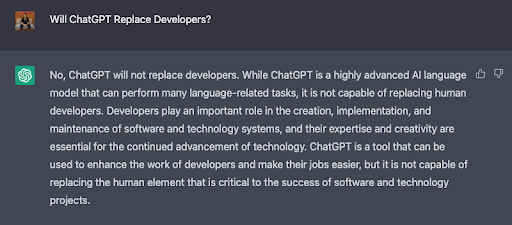Can ChatGPT Replace Developers? Exploring AI's Impact on the Workforce
In this blog, we will be exploring the capabilities and limitations of ChatGPT in its current state, and most importantly, answering the question “Will ChatGPT replace developers?”.

Authored by: Karan Jagtiani

Karan is a Software Engineer with 1.5 years of experience working with various technologies across different domains. He currently works for HackerRank as a SDE, specifically, as Backend & DevOps engineer. If you want to connect with him or get to know him better, you can visit his website: https://karanjagtiani.com
ChatGPT has been gaining a lot of traction recently and it deserves all the recognition it is getting. Artificial intelligence (AI) has advanced significantly in recent years and has had a substantial impact on a number of industries. AI systems are being utilized to automate operations, streamline workflows, and increase efficiency across industries, from manufacturing to customer service.
Concern regarding AI's effects on the workforce, particularly in the software development[1] sector, is growing as technology continues to advance. Many people are wondering if the advent of cutting-edge language generation models like ChatGPT would lead to the eventual replacement of human professionals like software developers.
In this blog, we will be exploring the capabilities and limitations of ChatGPT in its current state, exploring the applications of ChatGPT and how it can help developers across the world, and most importantly, answering the question “Will ChatGPT replace developers?”.
Before we get into that, let’s understand what exactly is ChatGPT.
What is ChatGPT?
ChatGPT is an advanced Artificial intelligence model that is capable of generating human-like text based on the prompts that it is given. ChatGPT is a variant of the GPT-3[2], Generative Pretrained Transformer 3 developed by OpenAI. The model has been trained on an extremely large dataset of text from the internet, and it has the ability to generate text on a wide range of topics, from answering trivia questions to solving exams that have been recognized as difficult entry barriers for professionals.
Because it is trained on textual data, it is also capable of solving coding problems and providing code snippets for developers in almost any programming language!
Key features and capabilities of ChatGPT include:
Natural Language Understanding: ChatGPT can understand and process text input in natural language, making it capable of responding to various questions and prompts.
Contextual Responses: It generates contextually relevant responses to the input it receives, allowing for coherent and context-aware conversations.
Versatile Applications: ChatGPT can be used in various applications, such as chatbots, virtual assistants, content generation, language translation, and more.
Text Completion: It can help users complete sentences or generate text based on partial input, making it useful for content creation and writing assistance.
Language Translation: ChatGPT can translate text between different languages, making it a valuable tool for language translation tasks.
Knowledge Base Access: It can provide information and answer questions based on the knowledge it was trained on, up to its last training data in September 2021.
Creative Text Generation: ChatGPT can generate creative and imaginative text, including stories, poems, and fictional narratives.
conversational Abilities: It can engage in text-based conversations with users, making it suitable for chat applications and interactive dialogue.
Let’s take a look at the uses of ChatGPT when it comes to software development.
Uses of ChatGPT for Software Development
Code Generation
ChatGPT is not only capable of generating code in almost all the programming languages that you can think of, but also, creating entire projects from scratch if the right prompts are given.
Let’s give ChatGPT a prompt where it has to create a NodeJS, Express API that fetches blog records using Mongoose with pagination.
This is the code output it provides:
const express = require('express');
const router = express.Router();
const Blog = require('../models/Blog');
router.get('/', async (req, res) => {
const perPage = 10;
const page = req.query.page || 1;
const blogs = await Blog.find()
.sort({ createdAt: -1 })
.skip((perPage * page) - perPage)
.limit(perPage);
const count = await Blog.countDocuments();
res.json({
data: blogs,
meta: {
currentPage: page,
perPage,
pages: Math.ceil(count / perPage),
total: count,
},
});
});
module.exports = router;
It also provided some explanation along with the code:

Bug Solving / Output Finder
Along with producing output for a code sample, ChatGPT is also capable of identifying bugs in a given piece of code.
Let’s provide the QuickSort[3] algorithm to ChatGPT with an intentional bug in it:
# Python
def partition(array, low, high):
pivot = array[high]
i = low - 1
for j in range(low, high):
if array[j] <= pivot:
i = i + 1
(array[i], array[j]) = (array[j], array[i])
(array[i + 1], array[high]) = (array[high], array[i + 1])
return i + 1
def quick_sort(array, low, high):
if low > high:
pi = partition(array, low, high)
quick_sort(array, low, pi - 1)
quick_sort(array, pi + 1, high)
The recursive condition[4] in the quicksort method normally checks if low < high, but in the above code, I have intentionally reversed the condition. Let’s see whether ChatGPT is able to find the bug!

Documentation Generation
Let’s see if ChatGPT is able to generate code for documenting APIs, we’ll test it with one of the most commonly used API documentation tools called Swagger. Let's ask it to write code that generates a Swagger document for a Blogs model schema in NodeJS & Express. Let’s also provide a specific NPM package name.

Knowledge Base
As many of us are already aware of ChatGPT's knowledge capabilities and its ability to pass well-known entrance examinations, there is no difference when it comes to software development as well. As it is a language model trained using deep learning on a humongous data set, it is able to solve almost any knowledge-based question you can throw at it.
These were some examples of ChatGPT's advanced capabilities when it comes to software development, now let's take a look at what are its current limitations.
What are the limitations of ChatGPT?
- Bias towards its Training Data: Due to the bias and flaws in the training data, which is natural as it was trained on data scraped from all over the internet, ChatGPT's response quality and accuracy are constrained. This means that ChatGPT may produce responses that reflect any biases or mistakes present in the training set.
- Lack of Contextual Knowledge: ChatGPT generates text based on patterns in the training data, but it lacks a thorough understanding of the environment in which it is in. As a result, some prompts may receive inaccurate or improper responses.
- Limited Creativity: ChatGPT can produce text that resembles that of a human, but it lacks that human's imagination and creativity. As a result, it might not be able to come up with original or cutting-edge ideas or find solutions to challenging issues the way a person can.
ChatGPT, like any AI model, has its limitations. Here are some of the key limitations:
Lack of Real-Time Information: ChatGPT's knowledge is limited to what was available up until its last training data in September 2021. It doesn't have access to real-time information or events occurring after that date.
Contextual Understanding: While ChatGPT can generate coherent responses, it may sometimes fail to fully understand the context of a conversation, leading to incorrect or nonsensical answers.
Ambiguity Handling: ChatGPT may struggle with ambiguous queries and might provide responses that don't adequately address the user's intent. It may also guess the user's intention when the question is unclear.
Long-Term Coherence: ChatGPT might lose coherence or introduce inconsistencies over extended interactions when responding to long and complex queries.
Inappropriate Content: Despite efforts to filter out inappropriate content, ChatGPT can sometimes generate responses that are biased, offensive, or harmful. OpenAI has implemented safety mechanisms but may not catch all problematic content.
Repetitive Responses: ChatGPT can sometimes generate repetitive responses or overuse certain phrases, especially in longer conversations.
Lack of Critical Thinking: ChatGPT doesn't possess critical thinking abilities or common sense reasoning. It provides answers based on patterns in its training data, even if those answers don't make logical sense.
Privacy Concerns: Conversations with ChatGPT may be logged for quality and research purposes, which can raise privacy concerns if sensitive information is shared.
Dependency on Input: ChatGPT's responses depend heavily on the input it receives. Slight changes in phrasing can lead to different answers, and it may not always ask clarifying questions when the input is unclear.
Ethical and Bias Issues: Like many AI models, ChatGPT can inadvertently reflect and perpetuate biases present in its training data, potentially leading to biased or unfair responses.
Despite its limitations, ChatGPT is a valuable tool that can help in enhancing the work of software developers and make their lives easier. It can be used to automate repetitive tasks, freeing up developers to focus on more complex and creative work.
By using ChatGPT or similar tools as a reference, developers can quickly access information and get answers to technical questions without having to spend time searching for answers online. This can help improve the efficiency of the work, as well as reduce the time and effort required to meet deadlines.
However, if developers begin to abuse this tool by writing a prompt to ChatGPT for every minor issue/question without verifying or understanding the solution, it has the potential to build a poor habit and a significant dependency on the tool, which can stifle a developer's growth in learning. What I would recommend is that always look at tools like ChatGPT as assistants that are capable of saving your time and not a replacement for your work.
Will ChatGPT replace developers?
The development of ChatGPT and other similar models based on natural language is a major step forward in the field of Artificial Intelligence. This is just the beginning, as AI continues to evolve, it will change the way we live, work and interact with the world. As a species, humans are yet to see the full capabilities of AI and its potential to improve our lives.
Although ChatGPT is able to provide solutions for various problems and despite its advanced capabilities, in its current state, it is not capable of replacing human developers. ChatGPT is a tool that can be used to enhance the work of developers, but it cannot replace human intuition along with creativity which is essential for building large-scale software products.
In my opinion, ChatGPT, in fact, will keep getting better day by day, and there will be more tools that come along in the future. Instead of thinking about whether it may or may not replace developers, we should be taking advantage of it. Tools like this have the potential to help us focus more on creative tasks rather than working on mundane & repetitive tasks.
Before we wrap this blog, let’s see what ChatGPT itself has to say about the topic!

I think that ChatGPT is just being humble and does not want us to know about its master plan to replace us all 😄
Author's Note
Thank you for making it this far, I had a lot of fun writing this blog. If you want to connect with me, check out my website here, you can find all my social links along with my other work.
P.S. The most important question is, was this blog also written by ChatGPT? 🤔
Important links/Footnotes
[1] - Career options in software development
[2] - Generative Pretrained Transformer 3
[3] - 12 Must-Know Algorithms For Programmers
[4] - How does Recursion work?
FAQs
How does ChatGPT operate, and what is it?
An advanced AI model called ChatGPT was created by OpenAI using the GPT-3 architecture. Based on the commands it receives, it can produce text that appears to be written by a human. ChatGPT can generate text on various themes, comprehend natural language input, offer contextual responses, translate languages, and more, thanks to training on a sizable dataset of internet content.
Can ChatGPT replace developers?
ChatGPT is a useful tool that can help developers with various jobs. It cannot, however, fully replace human developers because it lacks their creativity, intuition, and capacity for managing intricate, extensive software development projects. Instead of serving as a replacement, ChatGPT should be viewed as an assistance to increase developer efficiency.

